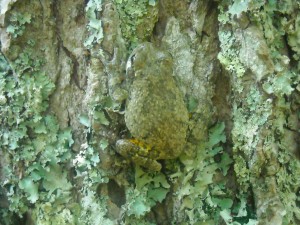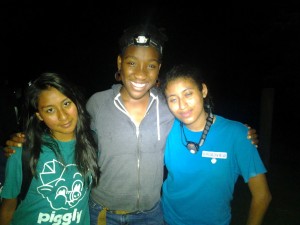About
Frogs and toads normally rely upon camouflage and their small size to remain hidden from predators and people. All of this changes during the mating season, when males begin to call to females. It is this time of year when scientists can most easily collect information about the distribution and relative abundance of calling amphibians. By examining the data from multiple years, scientists can identify trends in calling behaviors and changes in frog and toad populations.
Project Overview
In this study, students learn to identify species-specific frog calling patterns. During an evening frog call hike, HRE participants estimate the relative number of each species heard calling. They also record a variety of environmental conditions at the time of survey such as air temperature, wind speed, relative humidity and phase of the moon.
Inquiry Questions
What species of calling amphibians are found at each HRE study site?
Data Collection
Students record data based on a modified protocol outlined in the North Carolina Calling Amphibian Survey Project (http://www.ncparc.org/casp/casp-volpage.htm).
Beginning thirty minutes after sunset, students spend two minutes at five stops along a designated route. During the stop time, students listen for frogs.
At the end of the listening period, students discuss which frogs they heard and then determine an index of abundance:
Level I – Individuals can be counted and there is space between their calls
Level II – Some overlapping calls, but some individuals can be distinguished
Level III – Full chorus, calls constant, continuous, and overlapping
We record this data along with several environmental parameters like temperature and moon phase.
Data Sheets
We use the following data sheet for recording data in the field.
Frog Call Data Collection Sheet with 5 stops (Word)
Frog Call Data Collection Sheet with 5 stops (PDF)
Species Identified So Far
Chestnut Ridge Camp and Retreat Center
Fowler’s Toad (Bufo fowleri)
Northern Cricket Frog (Acris crepitans)
Cope’s Gray Treefrog (Hyla chrysoscelis)
Eastern Narrowmouth Toad (Gastrophryne carolinensis)
Bullfrog (Rana catesbeiana)
Green Frog (Rana clamitans)
Elon University
Fowler’s Toad (Bufo fowleri)
Northern Cricket Frog (Acris crepitans)
Cope’s Gray Treefrog (Hyla chrysoscelis)
Bullfrog (Rana catesbeiana)
Green Frog (Rana clamitans)
Rockfish Camp and Retreat Center
Oak Toad(Bufo quercicus)
Southern Cricket Frog (Acris gryllus)
Gray Treefrog (Hyla chrysoscelis)
Green Treefrog (Hyla cinerea)
Bullfrog (Rana catesbeiana)
Green Frog (Rana clamitans)


